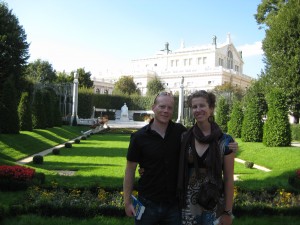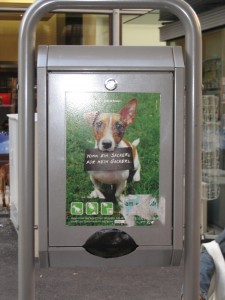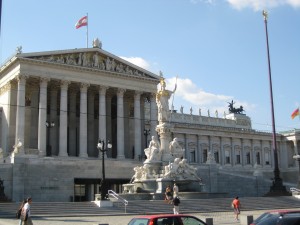I don’t think I will be able to use ‘wiener’ as a pejorative in the same way again (I have done so with considerable frequency in the past).   In German, Vienna is called Wien, and Viennese are called Wieners.  Wien may be my favourite city so far. Part of that may be the September timing of our visit, which seems to have fewer tourists. It is more expensive than the Eastern cities, but also cleaner, more friendly, and very beautiful.  It is refined and cultured but not stuffy; the people seem to be fairly relaxed, with a thriving café culture, well-patronized art scene and smiles and greetings on the street. Even Graham is impressed: “I think I could live hereâ€.

- Us in the Volksgarden, a giant public park. People hang out on benches reading books or stroll around or walk their dogs.
In contrast to the lack of queuing and pushy-grabby we saw in Eastern cities (a holdover from the communist era when there really wasn’t enough to go around and it paid to shove), the Wieners are used to having plenty and are very polite lining up. There also seems to be a strong propensity for the ‘honour system’ when it comes to paying for transit, newspapers and public washrooms. Bikes are barely locked up, and we were comfortable asking strangers (in broken Deutch-lish) to take our photo with our camera.  One thing they are not very good is cleaning up dog turds.  I’m not sure why, since this seems an integral part of the honour system, but there is a widespread campaign to get people to do it. In the meantime, picnics in the park are fraught with peril!

The architecture is AMAZING. The Hapsburg (Austro-Hungarian empire ruling family) who ran the place were Catholic and artistic, and it shows with all the massive fancy churches and public buildings – it seems the whole inner town is filled with massive fancy buildings, museums, palaces, civic buildings, theatres, etc. etc. There is also lots of public art, sculptures, and monuments (next post).  Postcards seem to always have great perspective shots of these buildings. Naturally ours who the buildings from street level and in situ – so enjoy the cyclists, streetcars, and other tourists in the shots – these are real working buildings (for the most part) that are embedded in a living city and I expect largely taken for granted by the Wieners.  Here are some highlights:



